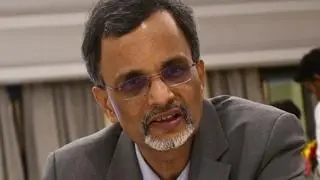Tucked away on Jackrabbit road, a one-hour drive from NASA's Johnson Space Center in Houston, Texas, is the assembly and distribution centre of Mahindra USA Inc, a subsidiary of the world’s largest tractor-maker by volume, Mahindra & Mahindra. One can find hundreds of red tractors and a few utility vehicles specifically made for the North American market showcased outside the factory. A banner over the entrance says in bold letters: “This is Mahindra territory.” Inside, the hangar-like building reverberates with grinding metal sounds as the machines and workers put the vehicle parts together.
In an interesting twist, Mahindra is among an increasing number of Indian companies that are expanding their operations or setting up businesses in the United States. Mani Iyer, chief executive at Mahindra USA, Inc said the firm expected to double its revenue to $1 billion in the next four years. He said the company had grown over four times in the last few years. But more than the growth, Mr.Iyer said it had been a great learning to do business in the U.S. The country has taught it to thrive in a tough market like North America, focus on innovation and helped it to become one of the top tractor manufacturers in the region.
“If you can drive in India, you can drive anywhere, but if you can sell in the U.S., you can sell anywhere in the world,” said Mr.Iyer.
Mindset changes
In the U.S. capital Washington D.C, the perception about the strength of Indian companies is changing among top government officials. They are now on a mission to promote and facilitate business investment from these firms. India became the fourth fastest-growing source of Foreign Direct Investment (FDI) in the U.S. in 2014, according to SelectUSA, a government programme to attract and retain business investment in the country. FDI by Indian firms into the U.S. has touched $11 billion. The U.S. affiliates of Indian-owned firms employed 45,100 American workers in 2013 mainly in industries such as software and IT services, financial services, pharmaceutical and industrial machinery.
“Thousands of companies in India today would have never even imagined or considered a place like the US to grow their business,” said Vinai Thummalapally, executive director of SelectUSA, during a media interaction at his office housed within the U.S. Department of Commerce, less than a mile away from the White House. A former college roommate of the U.S. President Barack Obama, Mr.Thummalapally said that US-India trade had jumped to$107 billion.
He said the U.S. government had set a goal to increase this trade by five-fold to $500 billion over the next decade. He also attributed this boost in Indo-US relations to the visits made my Prime Minister Narendra Modi and President Obama. “I came to the U.S. 42 years ago, but all the years I have seen, I have not seen this kind of activity,” said Mr.Thummalapally.
To woo Indian businesses, a US-India CEO Forum has also been created, with Tata Group chairman Cyrus Mistry as its co-chairman and David Cote, chief executive of Honeywell is heading the forum from the U.S. side.
“India is increasingly becoming an international investor,” said Marek Gootman, a director at Brookings Institution, a Washington-based think tank. He said India also had support from a huge Indian population in major metropolitan areas of the U.S. that understand both the markets.
Houston, the largest city in Texas, has over 102,000 people of Indian origin. Known as the 'Energy Capital of the World', it has attracted 20 Indian firms such as Reliance Industries, Sanmar Group, Tata Group and Wipro. They operate 28 subsidiary locations there. From 2005 to 2015, the trade between Houston and India increased at a compound annual growth rate of 9.6 percent according to Greater Houston Partnership, an economic development organisation.
Horacio Licon, a vice president at Greater Houston Partnership said India is leading the number of investment projects that the city is working on. “We are bringing Indian business people and actively encouraging 'speed-dating',” said Mr.Licon.
Andrew F.Icken, chief development officer for the City of Houston said that they had got the message that Prime Minister Modi delivered and it had resonated with the business community in the US. “The sense we got is that we are much more welcome now than we were three years ago,” said Mr.Icken, who visited India last year as part of a delegation comprising top U.S. government officials and business representatives.
Bob Pertierra, chief economic development officer for Greater Houston Partnership, who was part of the delegation, said the city was now actively pursuing a direct flight from Houston to India and is in talks with Air India. Mr.Pertierra aims to create 450,000 jobs in the region, some of which may also be created by other Indian firms such as Gitanjali Gems and steel and wire rope-maker Usha Martin that have operations there.
Acorns to oaks
In Virginia, Fairfax County is scouting for Indian companies which specialise in areas such as translational medicine, cloud computing, data analytics and cyber security, according to Gerald L. Gordon, president of the economic development authority in Fairfax. “Those are our strengths and there are a lot of such companies in Bangalore,” he said.
Fairfax, which is the second-largest suburban office market in the U.S., has attracted about 36 Indian companies including HCL, Hexaware Technologies and Infosys. Smaller firms like Rate Gain, Newgen Software, cyber security provider Paladion Networks and defence tech firm Grintex have also launched their operations there.
Sudhakar Shenoy, an top Indian-American entrepreneur said that what makes Fairfax attractive for these Indian companies are projects of the government that spends billions of dollars on just information technology. He said the other opportunities are large Virginia-based U.S. defence contractors such as Northrop Grumman and General Dynamics with software technology budgets that are as big as the government's spending on IT.” Many (Indian) companies end up doing business with them,” said Mr. Shenoy, chief executive of Virginia-based Alyx Technologies. “Mighty oaks grow from tiny acorns.”
Charming the Indians
In South Carolina, Governor Nikki Haley is aggressively wooing companies from India to set up businesses in the south-eastern region of the country. The first female governor of South Carolina, and currently the youngest governor in the U.S., even gives her personal mobile number to CEOs. “Indian companies don’t push themselves on you. I learned you have to invite them,” said Ms.Haley during a media interaction at her office in the South Carolina State House in Columbia. “We keep working with you even after you come to South Carolina. If that company wins, we win, if it loses, we feel we take the loss,” she said. Her state has attracted six India-based companies to set up their business including engineering services firm QuEST Global Services NA, business process outsourcing services organisation WNS Limited and home textile company Himatsingka America.
“We are seeing the economy of India is ready to move outside its borders for the first time,” said Robert M. Hitt III, South Carolina’s Secretary of Commerce. “We are not the only state trying to attract Indian firms. Indian business people are very good negotiators.”
(The writer was in the U.S. on the invitation of the U.S. Government)
(This article first appeared in The Hindu dated June 13, 2016)







Comments
Comments have to be in English, and in full sentences. They cannot be abusive or personal. Please abide by our community guidelines for posting your comments.
We have migrated to a new commenting platform. If you are already a registered user of TheHindu Businessline and logged in, you may continue to engage with our articles. If you do not have an account please register and login to post comments. Users can access their older comments by logging into their accounts on Vuukle.